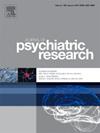Association between muscle strength and dementia in middle-aged and older adults: A nationwide longitudinal study
IF 3.2
2区 医学
Q1 PSYCHIATRY
引用次数: 0
Abstract
Background
As the population aging of the world, the number of people with dementia is increasing. The aim of this study was to investigate the potential impact of muscle strength on the risk of dementia among middle-aged and older adults in the UK.
Methods
This study used data from 5916 participants aged 50 years and over from the English Longitudinal Study of Ageing (ELSA) with a median follow-up of 9.2 years. Muscle strength was assessed by handgrip strength (HGS), standardized HGS (BMI- or weight-standardized), and chair-rising time, with participants categorized into tertiles by gender based on these measures. Cox Proportional Hazards Model was used to assess the association between muscle strength and risk of dementia.
Results
A total of 197 participants (3.33 %) developed dementia during follow-up. Regarding HGS, participants with low HGS had a higher risk of dementia (HR = 2.84, 95 % CI: 1.64–4.91). In analyses of standardized grip strength, participants with low muscle strength were also associated with a higher risk of dementia: BMI-standardized grip strength (HR = 2.20, 95 % CI: 1.35–3.58) and weight-standardized grip strength (HR = 1.74, 95 % CI: 1.11–2.74). In addition, those who spent more time standing had a higher risk of dementia than those who spent less (HR = 2.75, 95 % CI: 1.71–441) in an analysis of Chair rising time, which represents lower limb muscle strength. Subgroup analyses showed that these associations remained stable across age [in the middle-aged (50–64 years) and elderly (≥65 years) groups] and sex groups. The results of sensitivity analyses after excluding participants diagnosed with dementia within 2 years of baseline remained consistent with the main analysis.
Conclusions
In conclusion, this study demonstrated that muscle strength (including HGS, standardized HGS and Chair rising time) is strongly associated with the development of dementia. Thus, muscle strength (including upper and lower extremity strength) plays a key role in preventing and delaying dementia, highlighting the importance of extremity muscle strength in dementia risk assessment. These findings provide new perspectives for the development of muscle strength intervention strategies in middle-aged and older populations and provide a scientific basis for the early detection and prevention of dementia.
中老年人肌肉力量与痴呆之间的关系:一项全国性的纵向研究。
背景:随着世界人口老龄化,痴呆症患者数量不断增加。这项研究的目的是调查肌肉力量对英国中老年人患痴呆症风险的潜在影响。方法:本研究使用来自英国老龄化纵向研究(ELSA)的5916名年龄在50岁及以上的参与者的数据,中位随访时间为9.2年。肌肉力量通过握力(HGS)、标准化HGS (BMI或体重标准化)和椅子上升时间来评估,参与者根据这些指标按性别分为三类。采用Cox比例风险模型评估肌肉力量与痴呆风险之间的关系。结果:共有197名参与者(3.33%)在随访期间出现痴呆。关于HGS,低HGS的参与者有更高的痴呆风险(HR = 2.84, 95% CI: 1.64-4.91)。在标准化握力分析中,肌肉力量低的参与者也与痴呆的高风险相关:bmi标准化握力(HR = 2.20, 95% CI: 1.35-3.58)和体重标准化握力(HR = 1.74, 95% CI: 1.11-2.74)。此外,在对起立时间(代表下肢肌肉力量)的分析中,站立时间长者患痴呆的风险高于站立时间短者(HR = 2.75, 95% CI: 1.71-441)。亚组分析显示,这些关联在不同年龄[在中年(50-64岁)和老年(≥65岁)组]和性别组中保持稳定。在排除基线2年内诊断为痴呆的参与者后,敏感性分析的结果与主要分析保持一致。结论:总之,本研究表明肌力(包括HGS、标准化HGS和Chair上升时间)与痴呆的发生密切相关。因此,肌肉力量(包括上肢和下肢力量)在预防和延缓痴呆中起着关键作用,凸显了肢体肌肉力量在痴呆风险评估中的重要性。这些发现为中老年人群肌力干预策略的制定提供了新的视角,为早期发现和预防痴呆提供了科学依据。
本文章由计算机程序翻译,如有差异,请以英文原文为准。
求助全文
约1分钟内获得全文
求助全文
来源期刊

Journal of psychiatric research
医学-精神病学
CiteScore
7.30
自引率
2.10%
发文量
622
审稿时长
130 days
期刊介绍:
Founded in 1961 to report on the latest work in psychiatry and cognate disciplines, the Journal of Psychiatric Research is dedicated to innovative and timely studies of four important areas of research:
(1) clinical studies of all disciplines relating to psychiatric illness, as well as normal human behaviour, including biochemical, physiological, genetic, environmental, social, psychological and epidemiological factors;
(2) basic studies pertaining to psychiatry in such fields as neuropsychopharmacology, neuroendocrinology, electrophysiology, genetics, experimental psychology and epidemiology;
(3) the growing application of clinical laboratory techniques in psychiatry, including imagery and spectroscopy of the brain, molecular biology and computer sciences;
 求助内容:
求助内容: 应助结果提醒方式:
应助结果提醒方式:


